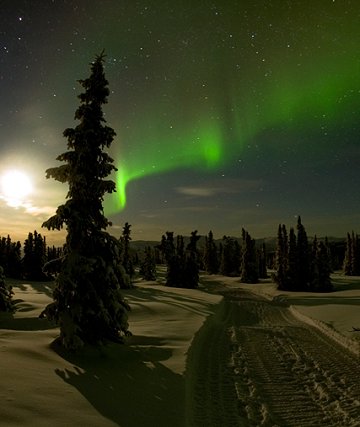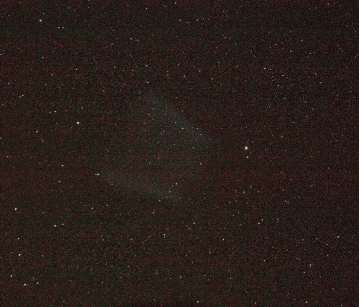| DOOMED SNOWBALL: Last week, on Feb. 23rd, the Solar and Heliospheric Observatory (SOHO) watched a comet plunge into the sun and disintegrate. The doomed snowball was a member of the Kreutz sungrazer family. Named after a 19th century German astronomer who studied them in detail, Kreutz sungrazers are fragments from the breakup of a giant comet some 2000 years ago. More than a thousand of these fragments have been catalogued by SOHO since the observatory was launched in 1995. Most are small and faint, but this one was a beauty. Watch the movie. AURORA WATCH: On March 3rd at 1:49 am, Alaska time, photographer Amara Eren stood shivering in the minus 20-degree air at Chena Hot Springs outside Fairbanks. "It was bitterly cold--even without the wind," she says. But, oh, what a view: 
Photo details: Nikon D3, f/4, ISO 400, 75 second exposure.
The display was caused by a minor solar wind stream buffeting Earth's magnetic field. The solar wind is expected to intensify (a little) during the next 24 hours, and NOAA forecasters estimate a 20% chance of high-latitude geomagnetic activity. Arctic sky watchers should remain alert for auroras. March 2009 Aurora Gallery
[previous Marches: 2008, 2007, 2006, 2005, 2004, 2003, 2002] RUSSIAN COMSAT CLOUD: "On Saturday evening, February 28th, I was observing at the Astronomical Society of Victoria dark-sky site near Heathcote, Australia," reports Michael Mattiazzo. "At 21:45 AEDT (10:45 UT) I happened to glance westwards and noticed a mysterious V-shaped glow just below Alpha Ceti. During the 5 minutes I spent aligning the telescope and setting up my camera on piggyback, it expanded considerably." He combined four images from his Canon 300D to create this 6-minute animation: 
"[The object that emitted the cloud] can be seen in my animation heading in an easterly direction toward the right side of the photo. Satellite expert Tony Beresford has identified it as a new Russian military comsat launched from Baykonur on Feb 28th." The name of the comsat is Raduga-1; it is an improved version of the Soviet-era old Gran' (Raduga) satellite first launched in 1975. Two burns were required to place Raduga-1 into geosynchronous orbit and purely by chance Mattiazzo saw one of them. It just goes to show ... you never know what you might see if you keep looking up.
Comet Lulin Photo Gallery
[Comet Hunter Telescope]
Explore the Sunspot Cycle | 
